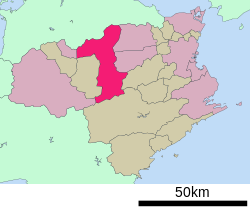Mima, Tokushima
|
Mima 美馬市 |
||
|---|---|---|
| City | ||
|
||
 Location of Mima in Tokushima Prefecture |
||
| Location in Japan | ||
| Coordinates: 34°3′N 134°10′E / 34.050°N 134.167°ECoordinates: 34°3′N 134°10′E / 34.050°N 134.167°E | ||
| Country | Japan | |
| Region | Shikoku | |
| Prefecture | Tokushima Prefecture | |
| Government | ||
| • Mayor | Hisashi Makita | |
| Area | ||
| • Total | 367.38 km2 (141.85 sq mi) | |
| Population (October 1, 2009) | ||
| • Total | 32,844 | |
| • Density | 89/km2 (230/sq mi) | |
| Symbols | ||
| • Tree | Salix babylonica | |
| • Flower | Crape-myrtle | |
| • Bird | Pendrocopos major | |
| Time zone | Japan Standard Time (UTC+9) | |
| City hall address | 5 Anabuki-cho, Anabuki-ji-kutanchi, Mima-shi, Tokushima-ken 777-8577 |
|
| Website | www |
|
Mima (美馬市 Mima-shi?) is a city located in Tokushima Prefecture, Japan.
The modern city of Mima was established on March 1, 2005, from the merger of the former towns of Mima, Anabuki and Waki, and the village of Koyadaira (all from Mima District).
As of 2009, the city has an estimated population of 32,844 and a population density of 89.401 persons per km². The total area is 367.38 km². About 20.1% is inhabitable land.
The name Mima (美馬) is derived from two characters meaning "Beautiful Horse". Mima was once home to many horse breeders. Although breeders and keepers are not so common in present-day Mima, the history lives on today in art, local products, and such.
There is also the story of a famous horse named Ikezuki. He is a famous horse born from a captive Mima Town mother and a wild father from Mount Tsurugi. He later belonged to Shogun Yoritomo and often makes appearances throughout history, such as in Tale of Heike, Genpei War, and The Battle of Uji (1184) (crossing the Uji River). Ikezuki's mother was buried at what is now Ikezuki Park. It is unsure whether Ikezuki is a factual or fictional character.
Straight from the Edo and Meiji Eras, Udatsu Townscape is a symbol of Wakimachi’s old days. Characteristic of the buildings are the presence of “Udatsu,” extensions of the roof that served as protection from the spread of fires. Udatsu were also symbols of fortune, and continue to proclaim the prosperity of the merchants even today. The charm of the old town continues to excite nostalgia, as the broadcast industry often features it in television dramas and commercials. The national government recognized Udatsu Street as an “Important Preservation District for Groups of Historic Buildings” in December 1988.
...
Wikipedia


